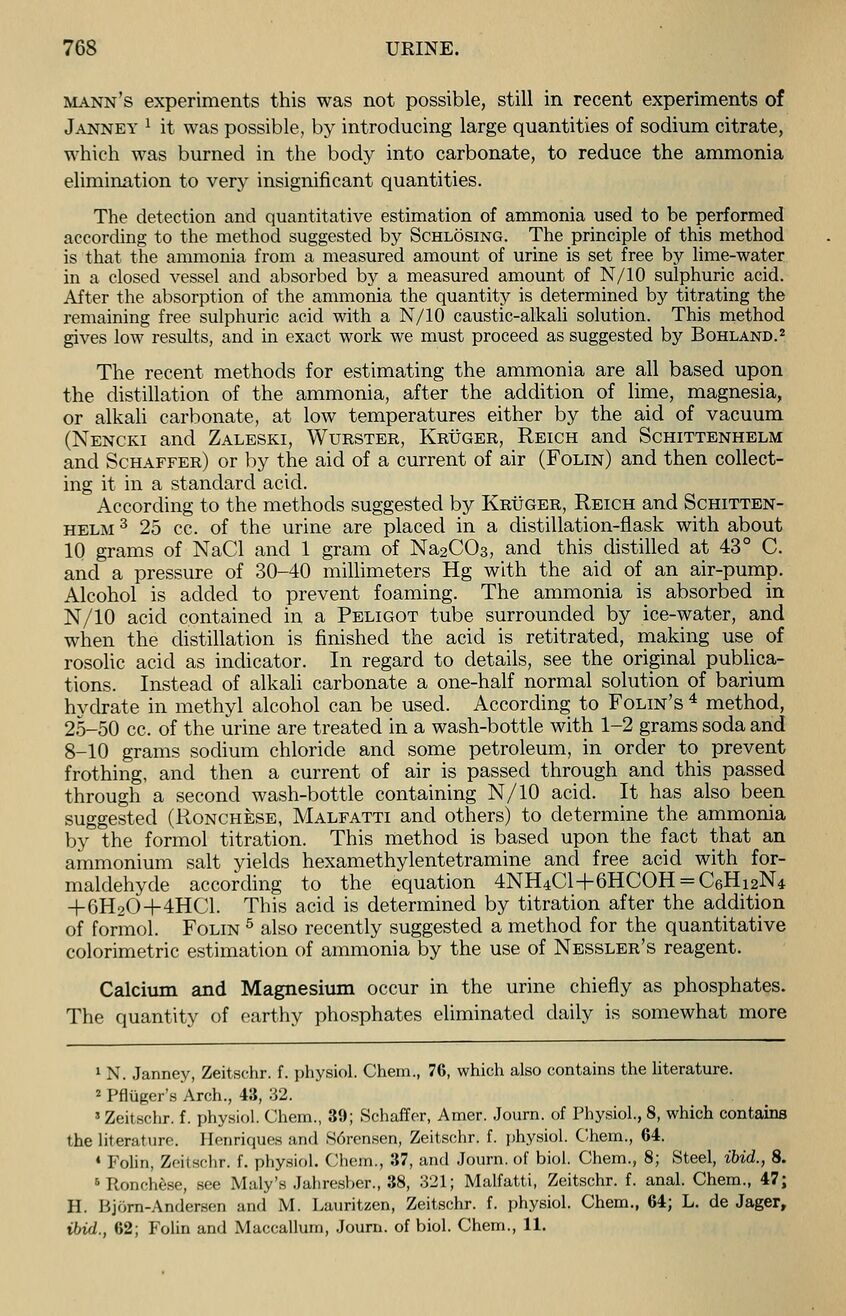
Full resolution (JPEG) - On this page / på denna sida - XIV. Urine - III. Inorganic Constituents of Urine

<< prev. page << föreg. sida << >> nästa sida >> next page >>
Below is the raw OCR text
from the above scanned image.
Do you see an error? Proofread the page now!
Här nedan syns maskintolkade texten från faksimilbilden ovan.
Ser du något fel? Korrekturläs sidan nu!
This page has never been proofread. / Denna sida har aldrig korrekturlästs.
768 URINE.
mann’s experiments this was not possible, still in recent experiments of
Janney !
it was possible, by introducing large quantities of sodium citrate,
which was burned in the body into carbonate, to reduce the ammonia
elimination to very insignificant quantities.
The detection and quantitative estimation of ammonia used to be performed
according to the method suggested by Schlosing. The principle of this method
is that the ammonia from a measured amount of urine is set free by lime-water
in a closed vessel and absorbed by a measured amount of N/10 sulphuric acid.
After the absorption of the ammonia the quantity is determined by titrating the
remaining free sulphuric acid with a N/10 caustic-alkali solution. This method
gives low results, and in exact work we must proceed as suggested by Bohland.2
The recent methods for estimating the ammonia are all based upon
the distillation of the ammonia, after the addition of lime, magnesia,
or alkali carbonate, at low temperatures either by the aid of vacuum
(Nencki and Zaleski, Wurster, Kruger, Reich and Schittenhelm
and Schaffer) or by the aid of a current of air (Folin) and then collect-
ing it in a standard acid.
According to the methods suggested by Kruger, Reich and Schitten-
helm 3 25 cc. of the urine are placed in a distillation-flask with about
10 grams of NaCl and 1 gram of Na2 CC>3, and this distilled at 43° C.
and a pressure of 30-40 millimeters Hg with the aid of an air-pump.
Alcohol is added to prevent foaming. The ammonia is absorbed in
N/10 acid contained in a Peligot tube surrounded by ice-water, and
when the distillation is finished the acid is retitrated, making use of
rosolic acid as indicator. In regard to details, see the original publica-
tions. Instead of alkali carbonate a one-half normal solution of barium
hvdrate in methyl alcohol can be used. According to Folin’s 4 method,
25-50 cc. of the urine are treated in a wash-bottle with 1-2 grams soda and
8-10 grams sodium chloride and some petroleum, in order to prevent
frothing, and then a current of air is passed through and this passed
through a second wash-bottle containing N/10 acid. It has also been
suggested (Ronchese, Malfatti and others) to determine the ammonia
by the formol titration. This method is based upon the fact that an
ammonium salt yields hexamethylentetramine and free acid with for-
maldehyde according to the equation 4NH4Cl-f-6HCOH==C6Hi2N4
+6H2 0+4HC1. This acid is determined by titration after the addition
of formol. Folin 5 also recently suggested a method for the quantitative
colorimetric estimation of ammonia by the use of Nessler’s reagent.
Calcium and Magnesium occur in the urine chiefly as phosphates.
The quantity of earthy phosphates eliminated daily is somewhat more
1
N. Janney, Zeitschr. f. physiol. Chem., 76, which also contains the literature.
2
Pfliiger’s Arch., 43, 32.
3
Zeitschr. f. physiol. Chem., 39; Schaffer, Amer. Journ. of Physiol., 8, which contains
the literature. Henriques and S6rensen, Zeitschr. f. physiol. Chem., 64.
•
Folin, Zeitschr. f. physiol. Chem., 37, and Journ. of biol. Chem., 8; Steel, ibid., 8.
6
Ronchese, see Maly’s Jahresber., 38, 321; Malfatti, Zeitschr. f. anal. Chem., 47;
il. BjOrn-Anderseii and M. Lauritzen, Zeitschr. f. physiol. Chem., 64; L. de Jager,
ibid., 62; Folin and Maccallum, Journ. of biol. Chem., 11.
<< prev. page << föreg. sida << >> nästa sida >> next page >>